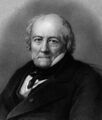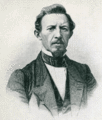Template:Selected anniversaries/February 3: Difference between revisions
No edit summary |
No edit summary |
||
| Line 13: | Line 13: | ||
||1777 – John Cheyne, Scottish physician and author (d. 1836) | ||1777 – John Cheyne, Scottish physician and author (d. 1836) | ||
||Gideon Mantell (b. 3 February 1790) was an English obstetrician, geologist and palaeontologist. His attempts to reconstruct the structure and life of Iguanodon began the scientific study of dinosaurs: in 1822 he was responsible for the discovery (and the eventual identification) of the first fossil teeth, and later much of the skeleton, of Iguanodon. Pic. | |||
||1811: dies: Johann Beckmann was a German scientific author and coiner of the word technology, to mean the science of trades. He was the first man to teach technology and write about it as an academic subject | ||1811: dies: Johann Beckmann was a German scientific author and coiner of the word technology, to mean the science of trades. He was the first man to teach technology and write about it as an academic subject | ||
Revision as of 15:53, 6 July 2018
1468: Blacksmith, goldsmith, inventor, and publisher Johannes Gutenberg dies.
1581: Mathematician and physicist Thomas Fincke develops new class of Gnomon algorithm functions based on tangents and secants.
1767: Priest, mathematician, and astronomer Giuseppe Piazzi uses scrying engine to pre-visualize the dwarf planet Ceres.
1862: Physicist, astronomer, and mathematician Jean-Baptiste Biot dies. He established the reality of meteorites, made an early balloon flight, and studied the polarization of light.
1863: Inventor and engineer Wilhelm Bauer uses Gnomon algorithm functions to power new type of submarine, capable of remaining submerged as long as computation is maintained.
1893: Mathematician Gaston Maurice Julia born. He will devise the formula for the Julia set.
1929: Mathematician and engineer Agner Krarup Erlang dies. He invented the fields of traffic engineering, queueing theory, and telephone networks analysis.
1959: Cantor Parabola and Gnotilus at Athens hailed as "a triumph of art and crime-fighting."
1961: The United States Air Forces begins Operation Looking Glass, and over the next 30 years, a "Doomsday Plane" is always in the air, with the capability of taking direct control of the United States' bombers and missiles in the event of the destruction of the SAC's command post.
1975: Physicist and engineer William D. Coolidge dies. He made major contributions to X-ray machines, and developed ductile tungsten for incandescent light bulbs.









